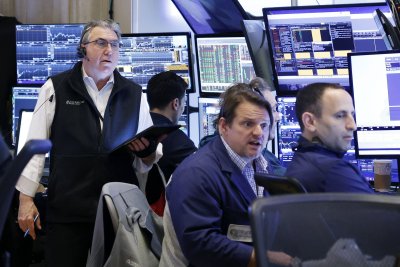May 2 (UPI) — U.S. stocks ended the week on a high note after a good nonfarms report for April and a willingness by China to soften the trade war with the United States, easing recession concerns.
The Standard & Poor’s 500, Nasdaq Composite and the Dow Jones Industrial Average index also ended last week in positive territory.
The three indices are above the day after April 2 when President Donald Trump announced tariffs on Liberation Day. The markets closed before his announcement.
The S&P rose 82.53 points, or 1.47%, to close at 5,686.67, the index’s ninth consecutive day of increases, the longest since November 2004. The record high was 6,144.15 on Feb. 19 but dropped to 4,982.77 on April 8.
The DJIA climbed 564.47, or 1.39%, to close at 41,317.43. The index hit a record 45,014 on Dec. 4 but had dropped as low as 37,645.59 on April 8.
And tech-heavy Nasdaq increased 266.99, or 1.51%, to close at 17,977.73. The index went into a bear market on April 4 for the first time since 2022 and further dropped to 15,267.913 on April 8. The record high was 20,173.89 on Dec. 16.
All 11 sectors tracked by CNBC rose Friday, led by communications services at 2.3%, financials at 2.15% and materials at 1.66%. The smallest was consumer staples at 0.6%
The benchmark 10-year bonds’ yield rose to 4.308%. Gold was at $3,247.40 for an ounce, below the record $3,425.30 on April 27. And West Intermediate Crude Oil was at $58.38 a barrel, the lowest since January 2021.
In the morning, the Commerce Department announced payrolls grew by 177,000 in April. It was down from 228,000 in March but much better than feared after recession worries ramped up last month. The unemployment rate stood at 4.2%.”
“Markets breathed a sigh of relief this morning as the jobs data came in better than expected,” Chris Zaccarelli, chief investment officer at Northlight Asset Management, told CNBC. “While recession fears are still simmering on the back burner, the buy-the-dip dynamic can continue — at least until the tariff pause runs out.”
“U.S. employment remains strong despite tariff uncertainty,” David Russell, global head of market strategy at TradeStation, in remarks obtained by CNN. “These numbers show leaders have breathing room to avoid a recession if they’re able to resolve trade issues sooner rather than later.”
On Wednesday, the government announced the U.S. gross national product contracted at 0.3%, the worst quarter since 2022. A recession is defined as consecutive quarters of negative GDP.
Also, China said it is evaluating starting trade negotiations with the United States.
“If the U.S. wants to talk, it should show its sincerity and be prepared to correct its wrong practices and canceled the unilateral tariffs,” CNBC reported.
Senior U.S. officials reached out “through relevant parties multiple times, a spokesperson for China’s Commerce Ministry said in a statement Friday.
The United States has slapped a 145% tariffs on products coming from China. That nation retaliated with 125%. Later, the United States exempted electronic products with them instead 20%.
Also, Trump signed an executive order Wednesday exempting imported cars and parts from the lofty levies.
“Everything is on the table for the economic relationship,” Treasury Secretary Scott Bessent said. “I am confident that the Chinese will want to reach a deal. And as I said, this is going to be a multistep process. First, we need to de-escalate, and then over time, we will start focusing on a larger trade deal.”
Trump has paused retaliatory tariffs announced on April 2 until July 9. They include America’s greatest allies: 26% against India, 25% against South Korea, 24% against Japan and 20% against the 27 members of the European Union.
It’s also 46% against Vietnam and 49% against Cambodia.
The baseline 10% tariffs remain against most of the U.S. trading partners.
